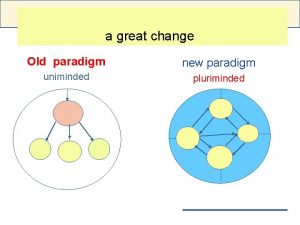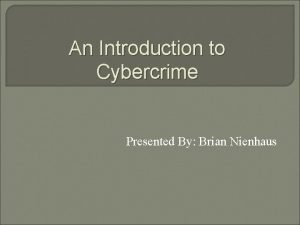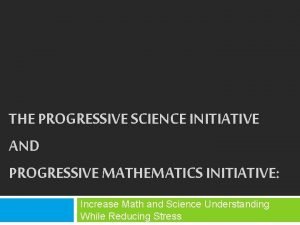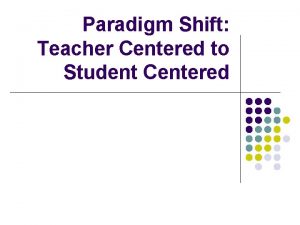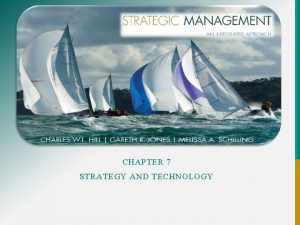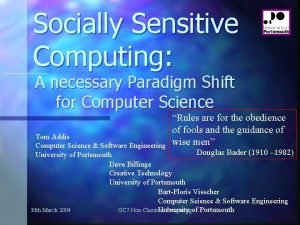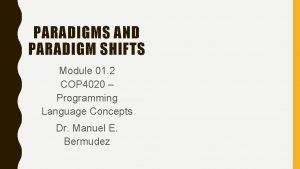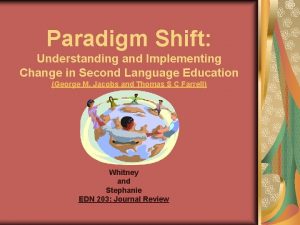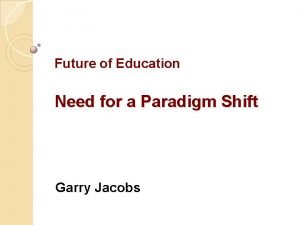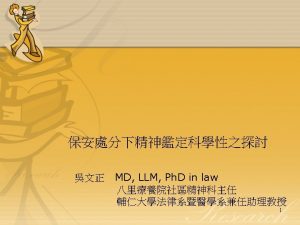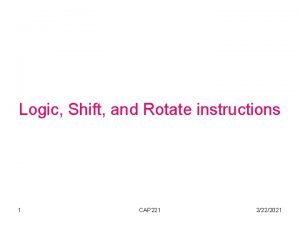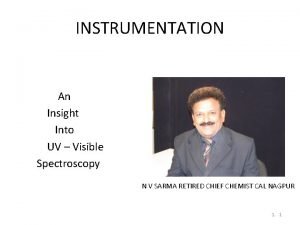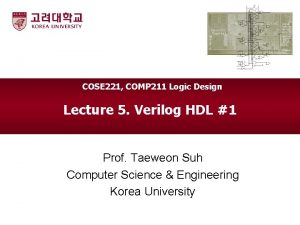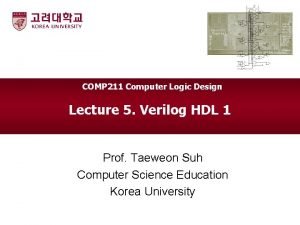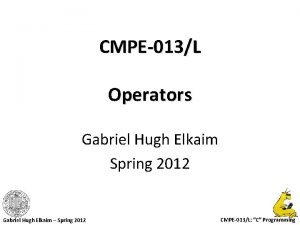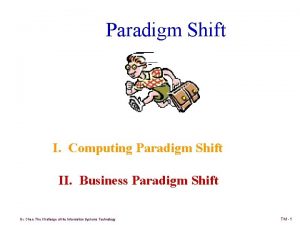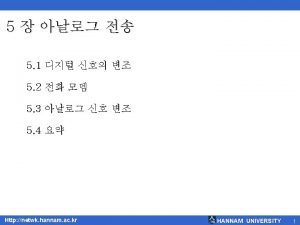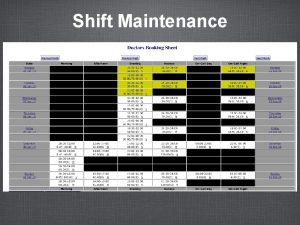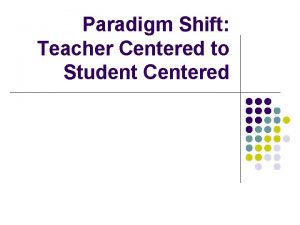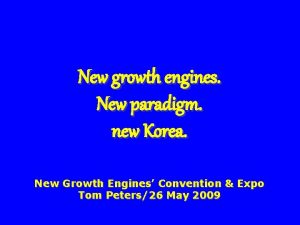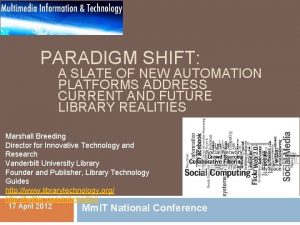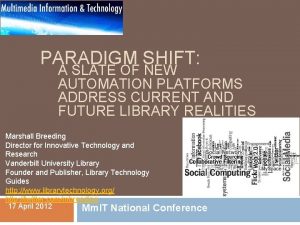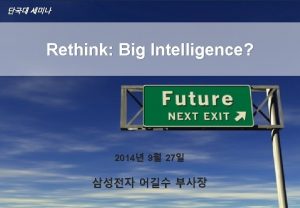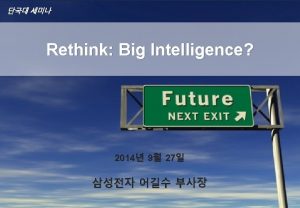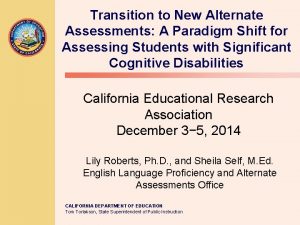Shift Happens On a New Paradigm of the



















- Slides: 19

“Shift Happens” On a New Paradigm of the Markets as a Complex Adaptive System by Michael J. Mauboussin Lecture Notes for Finance 450 CSULB Dr. Ammermann

References: • “Shift Happens” – www. capatcolumbia. com • The Warren Buffett Portfolio, by Robert Hagstrom – Ch. 8, “The Market as a Complex Adaptive System” • Chaos and Order in the Capital Markets, by Edgar Peters

3 Forms of Market Efficiency • Weak form – technical analysis – Supported by studies on autocorrelation – Contradicted by seasonality, subsequent performance of “winners” and “losers” • Semi-strong form – fundamental analysis – Supported by typical (under)performance of fund managers, also by many event studies – Contradicted by P/E and M/B effects, consistent outperformance of some fund managers (e. g. , the “Superinvestors of Graham-and-Doddsville”)

3 Forms of Market Efficiency • Strong form – insiders – Contradicted by subsequent performance of stocks after insider share repurchases

Areas of Potential Exploitation • Two areas of potential exploitation under traditional theory – Better information • Day traders, arbitrageurs? – Better analysis • Warren Buffett?

Areas of Potential Exploitation • Tension exists between academics and practitioners – Academics – rational agents, random walk, efficient markets – Practitioners – outperformance of some fund managers, irrational investors, inefficiency – One model reconciles both, bringing theory together with practice: The Market as a Complex Adaptive System (CAS)

Paradigm Shifts • • Thomas Kuhn Steps in process: 1. Theory laid out 2. Scientists test theory, but some facts counter it 3. Original theory stretched (to encompass new facts) 4. New theory developed to supercede the old

Paradigm Shifts • Example: 1. Aristotle proposes geocentric universe with orbits as circles 2. Astronomers observe the orbits are elliptical, not circular 3. Ptolemy introduces “circles-upon-circles” 4. Copernicus, Kepler, and Galileo introduce heliocentric universe, elliptical orbits, and celestial imperfection

2 Tests for a New Paradigm • Jeremy Bernstein’s test of “Correspondence” • 2 tests: – New idea must explain why the old theory worked – Must also add some predictive (or at least explanatory) power

Classical Capital Market Theory • Economics still largely based on equilibrium systems: supply vs. demand, price vs. quantity, risk vs. reward • Stems from the view of economics as a science akin to Newtonian physics – direct cause and effect, with implied predictability • Many statistical tools can only be applied if equilibrium theory holds

Classical Theory 1. Stock market efficiency – prices reflect all relevant information when that info. is cheap & widely disseminated – – Purchasing stocks as a zero-NPV proposition Prices not always “correct, ” but not systematically wrong 2. Random walk – security price changes are independent of each other – – Lots of agents – current prices reflect all info. that is collectively known Normal distribution of stock returns typically assumed in conjunction with this 3. Rational agents – investors can assess and optimize risk / reward opportunities 4. Assumptions / prediction – modest trading activity, limited price fluctuations directly attributable to specific news “events”

Classical Theory Tested 1. Stock returns are not normal – – 2. “fat tails, ” or “Noah Effect” Similar to “punctuated equilibrium” in biology Random walk not supported by data – – 3. 4. Elements of persistence – “Joseph Effect” Campbell, Lo, & Mac. Kinley show prices are predictable Volume higher & price changes greater than predicted Risk & reward not linked via variance – 5. Fama – firm size and M/B more important, so interpreted as risk factors Investors are not rational – – Systematic judgment errors have been identified Humans operate inductively, not deductively

Theory Stretched 1. Non-normal distributions – – 2. Typically ignored, or “outliers” simply removed from data Mandelbrot and stable Paretian distributions for financial data Noise traders (Black, 1986) – – – 3. “Noise” fills theory / practice gap Should not trade “Noise theories were all derived originally as part of a broad effort to apply the logic of the [CAPM] to … behavior that does not fit conventional notions of optimization. ” Crashes – – 4. Fama – “I think the crash in ’ 87 was a mistake” Miller – recommends reading Mandelbrot Behavioral finance – – “as if” argument – if many investors whose errors are independent with no systematic biases, aggregate market should appear rational Dilutes theory

New Theory – Market as Complex Adaptive System • Three components of complex adaptive systems: 1. Decision rules 1. Lots of agents, each operating with their own decision rules, with the most effective surviving 2. Provides the “adaptive” part of CAS 2. Emergence 1. Emergence = complex, large-scale behaviors resulting from aggregate interaction of less complex agents 2. e. g. , ant colony – individual ants have simple tasks, but combine together to create a very complex colony 3. e. g. , Adam Smith’s “invisible hand” 3. Market as a “Meta-System”

Market as a “Meta-System” • • “Meta-System” = market has properties and characteristics distinct from the agents / investors who comprise it Two key characteristics: – Nonlinearity • – Output of the system will not necessarily be proportional to the input Critical points • Periodically, small-scale stimuli lead to large-scale effects – – • “the straw that broke the camel’s back” Sand piles Leads to booms and crashes in the market

Does CAS Conform to Reality? • Adaptive behavior – leads to high trading volumes • Nonlinearity – contributes to fat-tailed return distributions • Trend persistence, but with low levels of autocorrelation, found in many complex adaptive systems • Homogeneous vs. heterogeneous expectations – Heterogeneous expectations may lead to risk / reward inefficiency – Deductive vs. inductive decision making – “El Farol” problem - Independent errors O. K. , nonindependent errors can lead to self-reinforcing trends

Does CAS Conform to Reality? • Portfolio manager performance – Not much predictability with CAS’s – Nonetheless, some investors may be “hardwired” to be good investors • E. g. , Warren Buffett, George Soros • Artificial stock market – Santa Fe Institute – Replicate market activity – Generates realistic market behavior

Practical Investor Considerations • Risk & reward link may not be clear – CAPM a possible first approximation, but far from the whole story! • Cause-and-effect thinking is dangerous – Human nature to identify cause and effect – But, with nonlinearity, large-scale changes can come from small-scale inputs (cf. Haugen, “Beast on Wall Street” – Crash of ’ 87 • Traditional DCF analysis remains valuable – Sets out first principles for stock valuation – Good framework for sorting out key issues in valuation – Helps investors crystallize / quantify expectations • Strategy / micro-economics

Why does EMH still win out? • Still hard to beat the market consistently – Implies EMH is a good first approximation • Strategy for Buffett’s “know-nothing” investors – Market efficiency is effectively accurate • Haugen’s counter-argument – Market so IN-efficient that investors cannot count on rational values to resurface • Justification for Buffett’s focus on “margin of protection” over and above “margin of safety” – Near the “wrong 20 -yard line” – Cf. , Ch. 15, “The Inefficient Stock Market”
 Old paradigm
Old paradigm Paradigm shift from women studies to gender studies
Paradigm shift from women studies to gender studies Paradigm shift from pedagogy to andragogy to heutagogy ppt
Paradigm shift from pedagogy to andragogy to heutagogy ppt It is the paradigm shift of script kiddies to crime bosses
It is the paradigm shift of script kiddies to crime bosses Njctl math
Njctl math Paradigm shift in technology
Paradigm shift in technology Paradigm shift teacher-centered to student-centered
Paradigm shift teacher-centered to student-centered Paradigm shift in technology
Paradigm shift in technology Paradigm shift meaning
Paradigm shift meaning Paradigm definition
Paradigm definition Paradigm shift in education
Paradigm shift in education Paradigm shift in education
Paradigm shift in education Paradigm shift kuhn
Paradigm shift kuhn Woodward fieser rules
Woodward fieser rules Molecular absorption
Molecular absorption Difference between arithmetic shift and logical shift
Difference between arithmetic shift and logical shift Bathochromic shift and hypsochromic shift
Bathochromic shift and hypsochromic shift Difference between arithmetic shift and logical shift
Difference between arithmetic shift and logical shift Logical shift and arithmetic shift
Logical shift and arithmetic shift Difference between arithmetic shift and logical shift
Difference between arithmetic shift and logical shift
